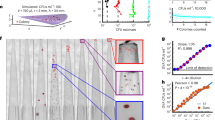Abstract
FOR many purposes the number of viable organisms has to be known. In antibiotic assays, for example, the size of the inoculum influences the result of the test1,2. Optical densities of bacterial suspensions, not corroborated by viable counts, are misleading, as dead cells are also registered. Viable numbers are usually estimated from poured plates3.
Similar content being viewed by others
References
World Health Org., Technical Rep. Ser., No. 210 (1961).
Seneca, H., and Peer, P., J. Amer. Geriatrics Soc., 11, 968 (1963).
Hinds, A. E., and Peterson, C. X., J. Bact., 86, 168 (1963).
Fisher, R. A., Statistical Methods for Research Workers, thirteenth ed., 61 (Hafner Publishing Co., Inc., New York, 1958).
Molina, E. C., Poisson's Exponential Binomial Limit (D. Van Nostrand Co., Inc., Princeton, New Jersey, 1942).
Author information
Authors and Affiliations
Rights and permissions
About this article
Cite this article
KOCH, W., KAPLAN, D. Enumerating Viable Bacteria. Nature 203, 896–897 (1964). https://doi.org/10.1038/203896a0
Issue Date:
DOI: https://doi.org/10.1038/203896a0
- Springer Nature Limited





